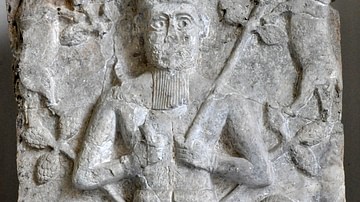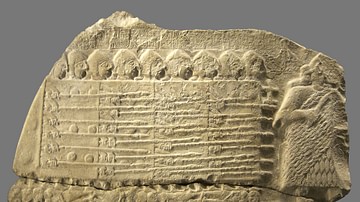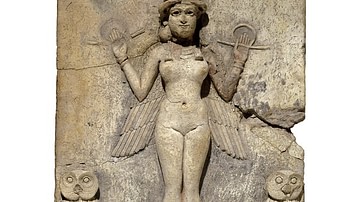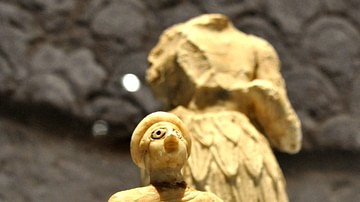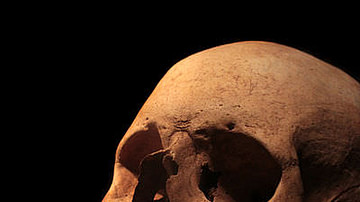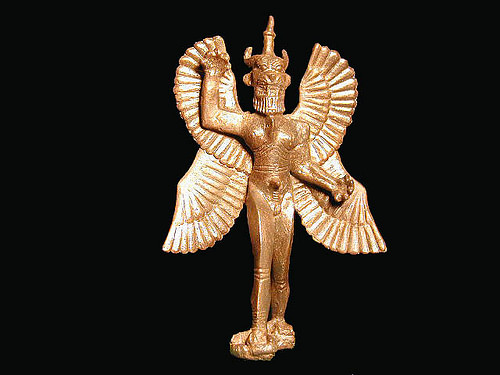
Pazuzu is an Assyrian/Babylonian demonic god who was most popular in the first millenium BCE. He was the son of Hanbi (also Hanba), king of the demons of the underworld, and brother to Humbaba, the demon-god protector of the Cedar Forest in The Epic of Gilgamesh who is killed by the heroes.
He was the demon of the underworld (where all demons were thought to reside) in control of the west and south-west winds which brought famine during the dry season and, in the rainy season, tearing storms and locusts. As he was the force behind the destructive winds and their threat, he was also considered the best defense against them. Similar in this way to the Egyptian god Set, prayers to Pazuzu were intended to divert his natural inclination toward destruction to the more benevolent ends of protection. Since it was clear he had great power to harm it was thought he was equally potent in protecting one from the very danger he presented.
Pazuzu is the most famous Mesopotamian demon in the present day and likely the only one people have ever heard of. As scholar Stephen Bertman notes, "though short on pizzazz, Pazuzu made it to Hollywood: he is the only Mesopotamian demon to have starred in a movie - The Exorcist" (125). In the 1973 horror film (based on the 1971 novel by William Peter Blatty), Pazuzu is the demon who possesses the Linda Blair character and is associated with the Christian Satan and the forces of evil.
Even so, although he was never considered the most benevolent of supernatural beings in ancient Mesopotamia - and was certainly regarded as an evil demon - he was not evil incarnate and was frequently invoked for protection from evil. He was particularly powerful in protecting pregnant women and children from the demon-goddess Lamashtu who preyed on unborn and newly-born babies.
The term "demon" in the modern day always carries with it the connotation of evil but this was not so in the ancient world. The English word "demon" is a translation of the Greek word daimon which simply meant "spirit". A daimon could be good or evil, depending on its intentions and the results of a visitation. In ancient Mesopotamia, as in other cultures of the ancient world, demons were often sent by the gods as punishment for sin or to remind one of one's duty to the gods and others in one's community. Demons were not always evil and even those who were, like Pazuzu, were still capable of good deeds.
Demons in Mesopotamia
In the Akkadian/Babylonian myth of the Atrahasis, human beings have grown too numerous, too loud, and far too fertile. Further, they live so long that more of them are being born at any given time than those who die. They cover the earth and disturb the god Enlil with their noise to such an extent that he decides to destroy them in a great flood. After the flood waters subside, the god of wisdom Enki proposes a plan to re-populate the earth: the gods will create a new kind of human with a shorter life span and greater threats to their lives on a daily basis. Henceforth there will be disease, miscarriages, impotency, sterility, attacks by wild animals, and all other manner of death waiting in a day.
Demons were a part of this divine plan and were sent to punish the wicked, test the righteous, and could even be given leave to torment someone because a certain god felt it was justified even though another disagreed. Demons who interfered with sexual intercourse and fertility were especially troublesome. The demon Samana, with his dragon's teeth, eagle talons, and scorpion's tail, was a constant threat and a Sumerian incantantion against him lists how he blocks the menstruation of the young girl, the potency of the young man, and the services of the courtesan and prostitute (Leick, 223). Samana could also affect crops, livestock and, according to Bertman, "had a special appetite for infants and prostitutes" (125). A demon of such malice and destructive power should have been held firmly in check by the gods and yet Samana was regarded as an agent of Gula, the goddess of health and healing, sent for reasons mortals would have to work out for themselves.
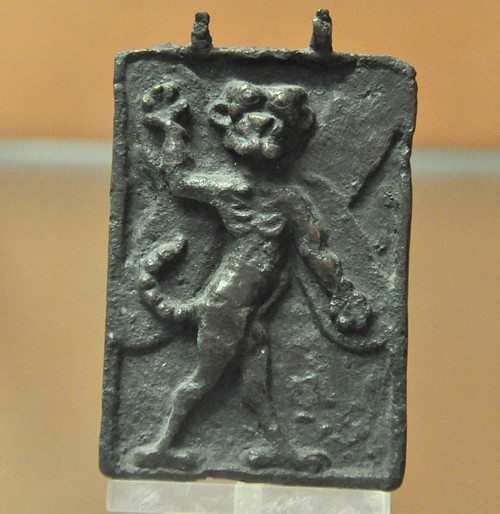
Pazuzu the Protector
One of the best ways to protect one's self against such attacks was to find a protector in an equally powerful demon who would stand between an individual and the wrath of the gods as a shield. Pazuzu was the most popular of these protective deities. He was mainly called upon to keep Lamashtu from murdering unborn or newly born babies but seems to have also been invoked against disease, impotency, and the ill effects of the west wind and south-west wind which blew from the direction of the land of the dead; the very winds Pazuzu himself controlled.
He is imagined as an especially frightening figure capable of scaring off any lesser demon or ghost. Pazuzu is represented in statuettes and engravings with bulging eyes in a canine face, a scaly body, snake-headed penis, the talons of a large bird, and enormous wings. In the opening scenes of The Exorcist he is depicted accurately in the life-sized statue the priest looks upon in the ancient city of Hatra.
In the novel, the author shows the priest handling a small statue of Pazuzu, not gazing upon a large figure, and this is also accurate. Although small statuettes of the demon have been found at Hatra, no full-sized statues have ever been found anywhere and it is unlikely they ever will be. Depictions of demons or deities associated with the underworld are rare because it was thought that, in creating such an image, one attracted the attention of the subject.
It is for this reason that few images exist of Ereshkigal, Queen of the Dead, and why even the famous Burney Relief (popularly known as the Queen of the Night) does not explicitly name its subject even though it most likely depicts Ereshkigal: to create an image of the Queen of the Dead would have been to call her attention to one's self and no one was especially interested in meeting her face-to-face.
The small statuettes and amuletic charms featuring Pazuzu had exactly the same effect: they drew Pazuzu's attention to the wearer or the room where the statuette was placed but their diminutive size concentrated their power toward protection. The individual mortal would have had nothing to fear from the demon because they were honoring him by asking for his protection and, when he came, he would turn his demonic powers on those threatening his charges, not on the individual mortal who had invoked him.
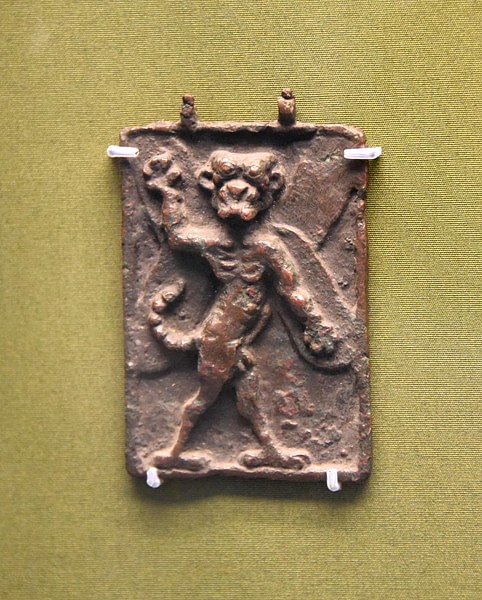
The Evolution of Demons
According to scholar Jeremy Black, demons in Mesopotamia evolved over the years from representations of threatening animals to personifications of the threat of danger and death. Black claims that Pazuzu is the ultimate expression of this evolution and provides a simplified chronology of the progress, breaking it into five phases:
1. A formative phase, in the late Ubaid and Uruk Periods, when the features of different animals were first combined into unnatural composite beings.
2. An optimistic phase, in the Akkadian Period, when glyphic scenes show the capture and punishment of nefarious demons.
3. A balanced phase, in the Old Babylonian Period, when cylinder seal designs often mix images (gods, symbols, and other motifs) of good and bad associations with respect to mankind.
4. A transformative phase, with Mitannian, Kassite, and Middle Assyrian Art of the fourteenth to eleventh centuries BCE, when the human-centered imagery of the Old Babylonian Period gave way to a preponderance of animal-headed hybrids.
5. A demonic phase, represented by Neo-Assyrian and Neo-Babylonian art, when individual demons were depicted in their full horror.
This last phase of development accords well with the new theology of a demonically populated underworld in the first millenium BCE. The change happens, moreover, at the same time as the advent of the practice of erecting in palaces and temples monumental statues and reliefs of magically protective beings, and of burying small clay images of them in the foundations. (63)
This evolution continued into the Hellenistic Period of Mesopotamian history and carried on into the Christian period. The Christians no longer had a need for protective demons and, of course, reliance on earlier religious beliefs was discouraged by the new faith. Demons, along with the old gods, had no place in the heaven of the Christian god and so were relegated to the Christian hell. Demons were already associated with the underworld and just as it was an easy step to turn the pagan afterlife into a hell of punishment, so it was to make demons agents of that eternal punishment as well as difficulties and dangers during one's life.
The gospels of the New Testament depict Jesus Christ routinely driving demons from various individuals and the Book of Acts, Revelation, and others describe demons in the service of God's adversary, Satan. In the letter of I John 4:1 in the New Testament the writer admonishes his readers to test every spirit to see if it is of God, and to reject it if it is not.
Demons were thereafter considered only as agents of evil, incapable of good save only inadvertently in serving God's overall plan. Pazuzu, an ancient Mesopotamian figure of fearsome aspect, was the perfect choice as the antagonist in The Exorcist as the audience had been primed through almost 2,000 years of instruction to accept the ancient demon-god as an instrument of evil. To the people of his day, however, Pazuzu was regarded as security and a shield against misfortunes in an uncertain and often frightening world.
